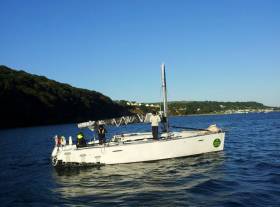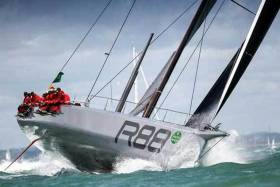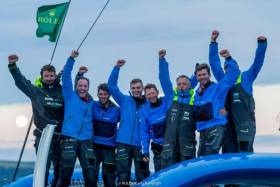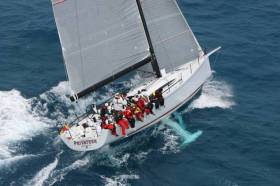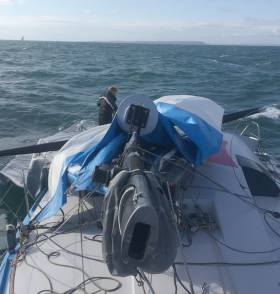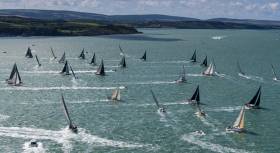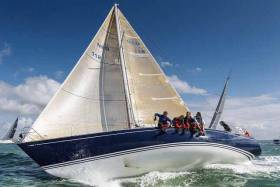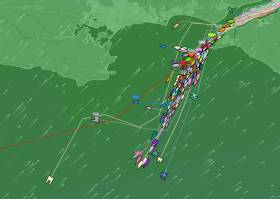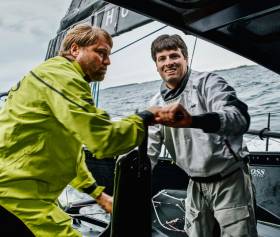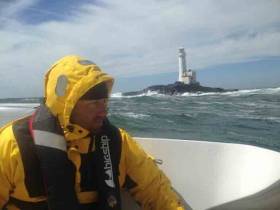Displaying items by tag: Fastnet
Cork Lifeboat Rescues Dismasted Fastnet Competitor
The Courtmacsherry RNLI Lifeboat completed the rescue of the 40–ft Fastnet Yacht Race competitor following the early morning callout at 3.21am this morning.
Both boats arrived to the Inner Harbour at Courtmacsherry in County Cork just after 8am this morning, after a three–hour tow from the casualty site, 13–miles east of the Galley Head.
The yacht got into difficulties after its mast broke earlier this morning.
Fastnet Yacht Race Fleet Try To Hold The Breeze
Heading into the third evening of the Rolex Fastnet Race 2017, with much of the heavy metal now on the homeward leg with a fair wind from the Rock to Plymouth, all are aware there’s a strong north wind out to the west writes W M Nixon. But the point of intense interest is how much – if at all – will it spread in towards the route from the Fastnet to the next mark at the Bishop Rock on the Isle of Scilly? Or will this area of stronger wind instead head on towards the Bay of Biscay, and leave the Fastnet fleet with only moderate to fresh breezes?
For the majority of the fleet, in other words the smaller boats still slugging towards the rock, moderate to fresh headwinds are all that’s required right now, thank you very much. But for the biggies going the other way, the more wind the merrier, and none are looking for it with as much determination as Alex Thomson and Nin O’Leary aboard the foiling IMOCA 60 Hugo Boss, which didn’t get round the rock until 3.00pm this afternoon. She was the last of her class, slowed to windward by her foils, but now she’s looking for big fair winds to get those foils working and hunt down the group ahead.
It’s a tall order, as the leading IMOCA 60, the veteran SMA, had worked out an astonishing lead of 72 miles, and even the other noted foiling IMOCA 60, Jean-Pierre Dick’s StMichel-Virbec, somehow manages to be more than 60 miles ahead, and is clearly getting her foils to do the business as she’s been showing 19 knots.
But out to the northwest, Hugo Boss is skirting the stronger wind on the starboard gybe, and showing speeds of 21 knots-plus. Nobody else in the entire race has shown figures like that until now, though Rambler 88 was sometimes getting between 18 and 19 knots. But if Hugo Boss can stay in that stronger wind and still manage to get a bit of easting into her course, it will make for a very interesting evening.
As for Rambler 88, like the good all-rounder she is, George David’s all-conquering silver bullet just kept going away from everyone regardless of the wind direction. Thus she was taking her gybe at the Bishop Rock at exactly the same time as Hugo Boss was rounding the Fastnet, and though she slowed briefly to 9 knots in a soft patch south of Land’s End, she’s now back at 17 knots and closing on the Lizard, first on the water and first in IRC, and a finish in Plymouth before midnight on the cards.
In the diverse Irish contingent, Paul Kavanagh’s Swan 44 Pomeroy Swan continues to do best, she lies 7th overall and first in class, while Michael Boyd with the First 44.7 Lisa is 18th overall and second in Class 2, though both of course still have quite a way to go before reaching the rock. As for Laura Dillon in the S&S 41 Winsome, they’ve been enjoying the open-water beat to haul the Harry Hiejst classic back up to 23rd overall, quite an achievement after being messed about by the calms east of the Lizard yesterday.
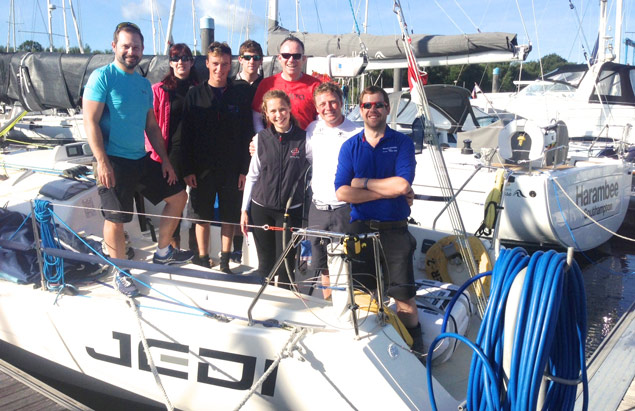 The crew of the Irish National Sailing School’s J/109 Jedi on Sunday morning before the Fastnet Race start, from left to right: Fearghus McCormack, Deirdre Foley, Lorcan Tighe,Conor Kinsella, Kylie McMillan, Keith Kiernan, Kenneth Rumball and George Tottenham
The crew of the Irish National Sailing School’s J/109 Jedi on Sunday morning before the Fastnet Race start, from left to right: Fearghus McCormack, Deirdre Foley, Lorcan Tighe,Conor Kinsella, Kylie McMillan, Keith Kiernan, Kenneth Rumball and George Tottenham
Of our two sailing school boats racing for the Roger Justice Trophy as well as class and overall honours, the Irish National Sailing School’s J/109 Jedi is currently well clear ahead of Irish Offshore Sailing’s Desert Star, while in the J/109 turnout generally, Mojito (Peter Dunlop & Vicky Cox, Pwllheli and National YC) is in the frame and also lying fifth in IRC 3.
While overall positions in the main part of the fleet can fluctuate with remarkable speed, the class placings are now beginning to settle down, and tomorrow we can look at them in more detail, when most boats should be finally round the Fastnet. Meanwhile, it’s going to be an increasingly rugged slug getting there with those stronger winds out to the northwest. However, their localized nature at present is underlined by the fact that Hugo Boss has just taken the gybe to get her more on course for the Bishop, and she’s already experiencing a slight easing of the pressure, with her speed back to 18.8 knots.
Tracker here
Unchallenged, Concise 10 blazed into Plymouth this morning, first boat home in the 47th Rolex Fastnet Race. Tony Lawson's MOD70 trimaran crossed the finish line off Plymouth breakwater at 05:55:00 BST with a race time of 42 hours and 55 minutes. This time didn't come close to the overall multihull record for the Rolex Fastnet Race but it was still respectable considering they sailed upwind all the way to the Fastnet Rock.
Dockside at Plymouth Yacht Haven, a beaming Tony Lawson commented: "To take the record for the Round the Island Race just a few weeks ago and then this... they deserve it, they have sailed well. Everyone thinks multihulls can't go to weather, but we led three state of the art monohulls around the Rock by about 100 miles and we led them into Plymouth by 200 miles. So if you want to go fast you have to get yourself a multihull!"
Skipper Ned Collier Wakefield said he had enjoyed the start, leaving the Solent amid the giant spectator fleet and the journey back from the Fastnet Rock: "Last night we gybed south and just sat there doing 30+ knots in flat water and brought that pressure all the way in. The moon was out so you could see what was going on." As to their exceptional performance to the Rock he added that the MOD70 was sailing upwind, typically making 21 knots at 50 degrees. "The MOD70 is an amazing machine. Every time we go out we still come back smiling."
Among Concise 10's crew were Paul Larsen, the world's fastest sailor (who sailed Vestas Sailrocket 2 at 65.45 knots average over 500m in 2012) and towering Rio 2016 Finn gold medallist and Land Rover BAR crew Giles Scott, sailing his first offshore race. "It was really good," said Scott. "Upwind, it felt like a long way out to the Fastnet, although I know a lot of the fleet have still got to go through all of that. On the turn round, when we started ripping downwind, Land's End didn't feel that far away at all. The fastest speed I saw was 36 knots."
But fairly pedestrian compared to the 40+ knot speeds he was seeing during the America's Cup in Bermuda? "Not at night in a seaway! These boats are awesome - get the boards set up right and they just fly. They are amazing bits of kit."
Ned Collier Wakefield said of his new crewman: "Giles enjoyed it. We scared him quite a few times! He's not used to heeling over quite so much! He was on the helm on that favourable run back from Bishop and he had a lot of fun. I think he might have the offshore bug - apart from the freeze-dried food... And the lack of sleep... And the cold..."
Back in the race proper the biggest monohulls are now round the Fastnet Rock and, thanks to their now sailing downwind are pulling ahead under IRC. At 0900 CET Rambler 88 was mid-Celtic Sea on a long gybe east, but had pulled into the lead, not just in IRC Zero, but overall under IRC, taking over the yellow jersey from the biggest boat in the Rolex Fastnet Race, the 115ft Nikata. These two giants displaced the smaller French boats Codiam and Pintia from the overall lead, although they remain ahead in IRC One and IRC Two respectively.
The bulk of IRC One is currently setting off across the Celtic Sea with Vittorio Biscarini's Mylius 15e25 Ars Una leading the charge on the water while handicap leader Codiam was astern and to weather. Overnight IRC One divided equally up the sides of the Traffic Separation Scheme off Land's End with the front runners on the water, Ars Una and James Neville's HH42 Ino XXX, taking the eastern route and Richard Fearon's RP45 Katsu and Dennis Maijer's Farr 45 Bucket List leading the charge up the west side, closer to the Scilly Isles. With the wind veering into the NNW, the boats have all tacked and are close to laying Fastnet Rock.
IRC Two are following a similar regime, however their lead trio on the water, Gilles Fournier and Corinne Migraine's J/133 Pintia, Nick and Suzi Jones' First 44.7 Lisa (skippered by RORC Commodore Michael Boyd) and Frans and Carla Rodenburg's First 40 Elke, all headed up the west side of the TSS while James Sweetman's First 40 Joanna of Cowes led the group up the east side off Land's End. The leaders in both groups tacked at around 0400 when they were close to laying Fastnet Rock.
Conversely the first group of boats in IRC Three took the eastern side of the Land's End TSS with Ed Fishwick and Nick Cherry on their Sun Fast 3600 Redshift Reloaded leading (on the water) up the east side alongside Ian Hoddle's sistership Game On. Meanwhile yesterday's IRC Three leader on corrected time, Altikhan - Linxea Valoris & Benefits, the A-35 of France's Johann Bouic, was first on the water heading up the west side of the TSS. However Arnaud Delamare and Eric Mordret's JPK 10.80 Dream Pearls is now leading IRC Three on corrected time.
Incredibly, the leaders among the smallest, slowest boats in IRC Four are also up among the IRC Two and Three boats. Again, there have been significantly differing tactics here with the two French JPK 10.10s: the Loisins' 2013 winner Night and Day and Noel Racine's Foggy Dew taking the eastern route while the present IRC Four leader, Paul Kavanagh's Swan 44 Pomeroy Swan, had gone west.
Among the professional classes, the stand-out performance remains that of the doublehanded crew of Paul Meilhat and Gwénolé Gahinet on the IMOCA 60 SMA, which is not only 23 miles ahead of the next boat in her class but also 7.5 miles in front of the first fully crewed VO65 Dongfeng Race Team. Among those VO65 crews competing on Leg Zero of the Volvo Ocean Race, the Chinese VO65 was first to round the Fastnet Rock at 07:58 this morning, followed eight minutes later by Team Akzonobel and then Mapfre. Bringing up the rear was Dee Caffari's fledgling crew on board Turn the Tide on Plastic at 08:55. All seven VO65s initially headed south with MAPFRE the first to gybe east.
In the Class40s Phil Sharp and Imerys were back in the lead this morning about two thirds of the way to the Fastnet Rock however, five other boats were looking threatening, especially yesterday's leader, Campagne de France, sailed by Halvard Mabire and Miranda Merron, the furthest north of the Class40s at present.
The Rolex Fastnet Race 2017 fleet leader, the MOD 70 trimaran Concise 10 owned by Tony Lawson and skippered by Ned Collier Wakefield, rounded the Fastnet Rock at 15.18hrs this afternoon in a nor’west breeze writes W M Nixon. But as none of the other active MOD 70s have come out to play this time round, Concise 10 is very much in a race of her own, and most interest focuses on the vast and varied mono-hull fleet which will be rounding the rock in the next two or three days.
The fleet ranges from the 115ft ft Nikata at one end down to the 30ft Silver Shamrock at the other, and the bulk of the boats – 312 in all – are racing in the IRC Division. The challenges of the 605-mile Fastnet course in typically northwest European summer weather have seen widely different boats top the leaderboard as each stage of the race passes through, with everything from the local wind patterns, the effect of nearby land, the sea state and the movement of the tides making an input into many separate moments of fleeting glory.
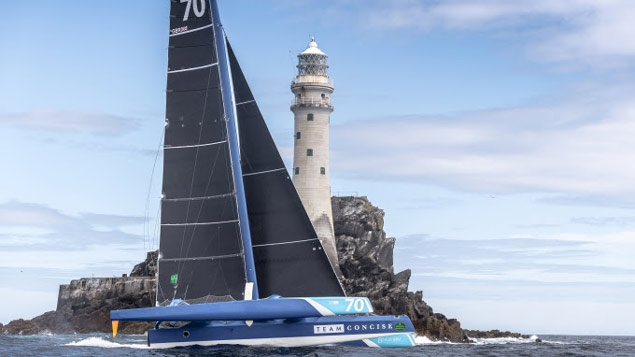 Rounding the Fastnet Rock on the southern tip of Ireland at 15:49 BST, Tony Lawson’s Concise 10 leads the fleet in the 2017 Rolex Fastnet Race. The MOD70 became the first yacht to round the race’s emblematic landmark and is making rapid progress some 115-nm ahead of the next boat on the water, George David’s Rambler 88. With 242-nm still to negotiate, Concise 10 was forecasting arrival in Plymouth on Tuesday morning and some way outside the current multihull line honours record of 32 hours, 48 minutes.
Rounding the Fastnet Rock on the southern tip of Ireland at 15:49 BST, Tony Lawson’s Concise 10 leads the fleet in the 2017 Rolex Fastnet Race. The MOD70 became the first yacht to round the race’s emblematic landmark and is making rapid progress some 115-nm ahead of the next boat on the water, George David’s Rambler 88. With 242-nm still to negotiate, Concise 10 was forecasting arrival in Plymouth on Tuesday morning and some way outside the current multihull line honours record of 32 hours, 48 minutes.
It is a fact of life that in any of the great classic offshore races, at some stage a Cookson 50 will come out of the woodwork and amaze everyone with her sudden prominence on the leaderboard, a position she may then maintain to the finish. It all goes back to well beyond the time in the Rolex Fastnet Race of 2007 when Ireland’s Ger O’Rourke took the top slot with Chieftain, for the Farr-designed Cookson 50 first appeared in 1996, which means she has been upsetting her competitors’ calculations for 21 years now.
The latest instance came this morning around 11 o’clock at the Lizard Point, when everyone was wondering why the IMOCA 60 Hugo Boss, with the not inconsiderable talents of Alex Thompson and Nin O’Leary on board, was going so slowly over towards Land’s’ End and was lying an ignominious 9th – or last if you prefer – in the IMOCA 60 Class.
Then suddenly observers became aware that a boat was coming round the Lizard at better than 8 knots, and passing that difficult headland with no bother whatever, proceeding on in pursuit of Hugo Boss and closing the gap to only five miles until the pursuer also slowed in the flukey winds and unsettled conditions.
But the private burst of speed of the American-owned Cookson 50 Privateer – for such it was – put her for a while in the top slot every which way. And though the boat – owned by Ron O’Hanley and skippered by Scott Innes-Jones – is now in the tricky conditons beyond the coast of North Cornwall, she’s still making 7.9 knots hard on the wind, and is still very much in sight of Hugo Boss.
The forecast is for the light west to northwest wind in the Celtic Sea to veer tonight, so the more northing the leaders can make while still on a course well west of north, the better it will stand to them when the new breeze firms in.
As expected, George David’s Rambler 88 leads on the water by more than twenty miles on the next group of biggies, and is currently on a course towards Youghal, but those astern will be waiting for her crucial tack as the veering calls the tune.
The star of the big boat group has to be the two-handed IMOCA 60 SMA (Paul Meihat and Gwenole Gahinet). She’s a gallant war horse of a boat which has been through a few traumas in her time, but Meihat and Gahinet have been sailing a race of genius. They not only have the IMOCA 60s well stitched up for now, but they’re sitting on top of every other big boat other than Rambler 88, including the mighty Nikata, the hyper-new 100ft CQS, and the Volvo 65s currently headed by Team Akzonobel.
The bulk of the fleet are still between Land’s End and Start Point, which is an awful lot of boats along an impressive distance of coastline. And with the local wind off the south coasts of Cornwall and Devon trying to be nor’westerly but with many flat patches, it may look like a lottery.
Yet the same two dozen names keep coming up at the front of the time sheets, and currently the fleet overall leader is the French J/133 Pintia skippered by Gilles Fournier with some formidable talents on board. They are currenty turning to windward in the middle of Mount’s Bay at 6 knots, first in IRC Overall and first in IRC 2.
Of the top eight boats, five are French, one is Italian, one is Dutch and one is British – make of that what you wish. Best-placed Irish is currently Paul Kavanagh’s Swan 44 Pomeroy Swan at 15th, while Alan Hannon’s Reichel Pugh 45 Katsu is in the top twenty, as too is Michael Boyd with the First 44.7 Lisa. But Harry Hiejst’s S&S 41 Winsome with which Laura Dillon had been having a scorcher of a race is in a flat spot east of the Lizard – as are dozens of other boats - and though fourth in IRC 4, she has slipped to 26th overall.
Tracker here
Royal Cork David Kenefick's Fastnet Race ambitions lie in ruins this evening after a dismasting on his class 40 entry. It's a disappointing outcome because Kenefick was in the mix in the top five of the ultra competitive Class 40 fleet. 'We lost are mast due to gear failure, Kenefick told Afloat.ie
It's a shock for the Cork Harbour helmsman who last week posted the top Irish result at the Moth Worlds, as Afloat.ie reported here.
'We managed to get the mast back on to the boat and headed into Weymouth, Kenefick told Afloat.ie
Following months of meticulous preparation for crews and organisers alike, a record-breaking edition of the Rolex Fastnet Race is underway and in some style. The largest fleet in the race’s 92-year history, comprising 368 yachts from 29 countries, were treated to kind conditions, blue skies and a consistent, building westerly breeze as they were divided across seven start sequences in front of the Royal Yacht Squadron’s clubhouse in Cowes.
The 2017 Rolex Fastnet Race fleet is truly diverse, a quality clearly evident to all of those watching on the shore in Cowes or the thousands following the live start of the race on the internet. First away were the nine multihulls with the MOD70 Concise 10 immediately asserting her status as favourite to arrive first in Plymouth. Speaking before the race skipper Ned Collier Wakefield was comfortable with this prediction, less so of setting a new race record. “The forecast has got a little slower. It’s not looking like record breaking conditions. We are expecting a 48-hour race.” The current multihull line honours record stands at 32 hours, 48 minutes.
Following the departure of the multihulls, the subsequent starts provided a showcase for a range of boats from cutting-edge to historic, professionally-sailed to family-crewed, the IMOCA 60s, Class 40s, through to the bulk of the fleet embodied by yachts in the 30-50-ft range including a large number sailing double-handed.
The final start was reserved for the largest and fastest monohulls. In this class, the range of designs and size of yachts is remarkable. At 115-ft Nikata, a high-performance cruising yacht, has become the largest monohull to ever compete in the race. Her nearest rival in size, Ludde Ingvall’s 100-ft CQS, was built with the more single-minded objective of racing fast. “CQS consists of a lot of different and radical ideas at the same time,” explains Ingvall. “It’s a very interesting boat and we are still learning a lot.” Ingvall was the last skipper to claim line honours and overall victory in the same year. That 1995 success is one he self-deprecatingly puts down to ‘getting lucky with the weather’. George David’s Rambler 88 is an offshore racing yacht par excellence and has the added experience of finishing the last edition of the race. The final starting group also comprised the seven competing Volvo 65s.
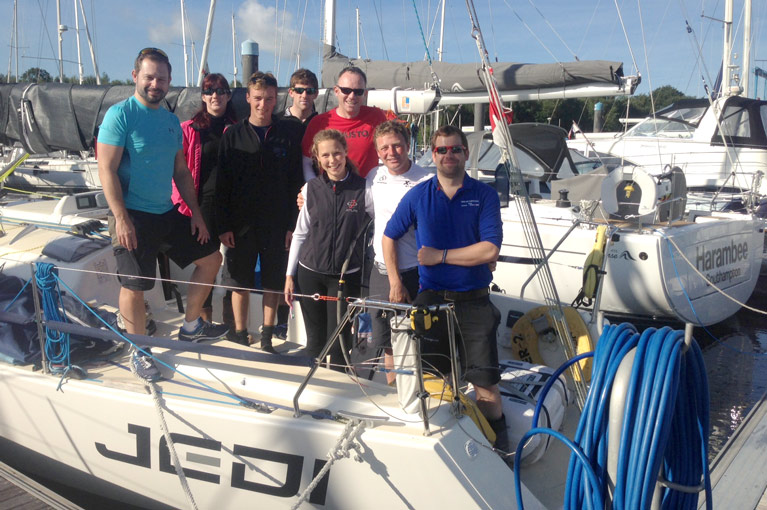 The Irish National Sailing School's Jedi crew ready for the off in Cowes. Photo: Alistair Rumball
The Irish National Sailing School's Jedi crew ready for the off in Cowes. Photo: Alistair Rumball
The general consensus among weather forecasters points to a ‘big boat race’, with good breeze on the upwind leg to the Fastnet rock before a cold front sets in heralding lighter conditions which may thwart the ambitions of the chasing fleet in their quest to claim the Fastnet Challenge Trophy and Rolex timepiece awarded to the overall race winner on IRC handicap.
Shortly after the race start the fleet converged in the Solent to offer one of sailing’s most iconic vistas. Safely negotiating the first congested few nautical miles of the course is a challenge in itself. The 605-nm race is a constant and genuine test of seamanship, resources, tactics and navigation. “The course is fantastic,” explains Pascal Loison, race winner in 2013 on Night and Day. “There are several headlands, and at each headland you have a new challenge. This is unique to the Fastnet course. Other offshore races are more direct, less complicated.”
The Solent laid on 'classic' conditions for the start of the Royal Ocean Racing Club's 47th Race. In brilliant sunshine and with brisk westerly winds gusting up to 20 knots, the giant fleet tacked up the western Solent before compressing through the usual bottleneck at Hurst Narrows.
The first start got underway at 11:00 BST for the nine multihulls and within minutes, the blue three-hulled streak that is Concise 10 had pulled out a lead, frequently heeling to an alarming degree, just one hull immersed. By the time IRC One was starting at 12:20 Tony Lawson's MOD 70, skippered by Ned Collier Wakefield, was already off Poole. Crewman Paul Larsen, who five years ago became the world's fastest sailor setting a world record of 65.45 knots, reported Concise 10 was sailing under reefed mainsail and staysail. "We're making 20 knots tacking past Poole and just dropping into the watch system. Glamour start conditions in the Solent. I can just see the next boats clearing Hurst Castle." However Larsen warned that unless the wind freed up, there was little chance for them to break the multihull race record. By 1500 Concise 10 was already level with Portland Bill.
The multihulls were followed away from Cowes by two other 'non-IRC' classes - the nine doublehanded IMOCA 60s and twenty seven Class40s. Given the upwind conditions, the older, conventionally foiled IMOCA 60s were prevailing. At 1630 Paul Meilhat and Jules Verne Trophy record holder crewman Gwénolé Gahinet aboard SMA, the 2012-3 Vendee Globe (and the 2013 Rolex Fastnet Race) winner as MACIF, were leading the 60s past Portland Bill. The first 'foil-assisted' IMOCA 60 was favourite Alex Thomson and Nicholas O'Leary on Hugo Boss in third place, taking a northerly route, close to the land.
In the Class40s present championship leader Phil Sharp on board Imerys led past St Alban's Head, but later there was little too choose with the British boat neck and neck for the lead in this incredible fleet with the Maxime Sorel-skippered V And B, Burkhard Keese's Stella Nova, Benoit Charon's LMAX Normandie and race veteran Halvard Mabire and Miranda Merron on Campagne de France.
The five IRC handicap classes, chasing the race's overall prize of the Fastnet Challenge Cup started with the smallest boats first at 1120.
This afternoon at 1600, the IRC One fleet had fanned out across the course to the southeast of St Alban's Head. James Neville's HH42 Ino XXX was leading the charge inshore as Staffan Wincrantz's Arcona 465 SALT 2.0 was ahead on the water to the south, just ahead of the venerable 1960s maxi Kialoa II, owned by Patrick Broughton.
Mid-afternoon, competitors in IRC Two were favouring the inshore route with Dutchman Frans Rodenburg's First 40 Elke, closest to St Alban's Head at 1620, with class favourite Gilles Fournier and Corinne Migraine's J/133 Pintia nearby.
The IRC Three boats were following a similar tactic with the offshore tack being less popular. Having started 20 minutes earlier, they were still successfully fending off the advances of the larger, faster IRC Two fleet. The Russian JPK 10.80, Igor Rytov's Boyatyr, was leading the pack inshore while the brilliantly-named Seafarers Ale Anticipation, the First 40.7 of former 470 Olympian Pete Newlands, was ahead on the water offshore.
The inshore-offshore spread was more evenly distributed among the smallest boats in IRC Four. Here Noel Racine's impeccably sailed JPK 10.10 Foggy Dew was ahead inshore while Dan Rigden's Elan 37 Tacktic was furthest down the track out to sea.
The last to start were the largest in the IRC fleet, IRC Zero, including the line honours contenders George David's Rambler 88 and Ludde Ingvall's 100ft CQS. By 1520 Rambler 88 was off and close into St Alban's Head, leading IRC Zero on the water just ahead of the biggest boat in the fleet, the 115ft Nikata.
Among the seven one design VO65s competing in 'Leg 0' of the 2017-18 Volvo Ocean Race, it was very close, with the Charles Caudrelier-skippered Dongfeng Race Team a nose ahead and making 12.3 knots but facing a threat from Team Brunel, skippered again by Dutch race veteran Bouwe Bekking, making 12.5 as the boats passed St Alban's Head.
This morning Xabi Fernández, skipper of MAPFRE, looked forward to the race: "Once out of the Solent it will be upwind sailing up to the Fastnet rock, and finally we will sail downwind towards Plymouth. This is the first time I've competed in the Rolex Fastnet Race. It is a historic race, much like the Rolex Sydney Hobart."
Joan Vila, MAPFRE's legendary navigator confirmed the forecast: "Once we leave the Solent, the wind will blow at around 20 knots. From there, it will drop until tomorrow morning, with the probability of encountering areas of very light wind. As we get closer to Plymouth, the wind will build again."
It’s classic Fastnet Race Day One evening conditions, with the fleet plugging to windward along the coast of Dorset, and the tide about to turn foul at Portland Bill writes W M Nixon. With the relatively rapid progress westward through the afternoon while the ebb was at its strongest, the Irish contingent in all its ramifications was having its moments of glory.
Of the boats mentioned yesterday in Sailing on Saturday as worth watching, at one stage we were in the dizzy position of having Peter Dunlop & Vicky Cox’s J/109 Mojito from Pwllheli, but with half her crew from the National YC, lying second overall, while Harry Heijst’s classic 41ft S & S Winsome, with Laura Dillon of Howth the No 1 helm, was in third.
With a fleet this size, the mix is re-jigged by the minute, and for a while our hottest hope was Paul Kavanagh’s vintage Swan 44 Pomeroy Swan, which is a regular and successful contender on the RORC programme in the English Channel, but is down in the entry list as being very much Irish.
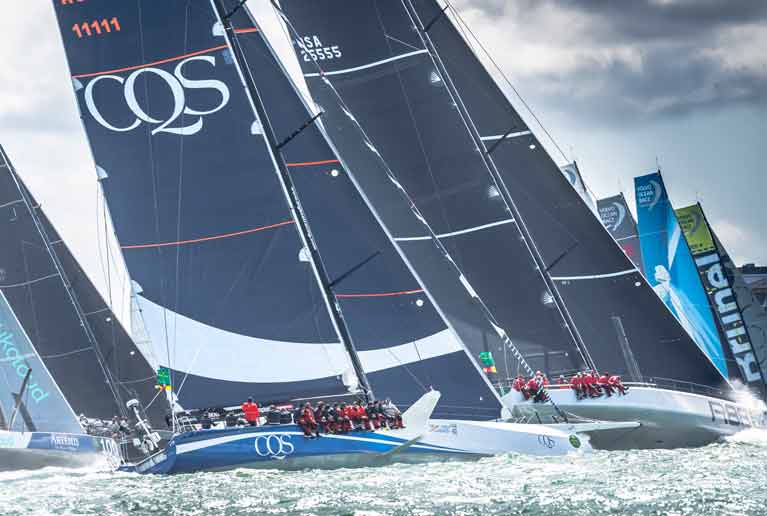 The Fastnet Race Start of the IRC Z & VO65 Classes Rambler 88, Sail No: USA 25555, Class: IRC Zero, Owner: George David, Type: Canting Keel Sloop Cqs, Sail No: AUS 11111, Class: IRC Zero, Owner: Ludde Ingvall, Type: Supermaxi
The Fastnet Race Start of the IRC Z & VO65 Classes Rambler 88, Sail No: USA 25555, Class: IRC Zero, Owner: George David, Type: Canting Keel Sloop Cqs, Sail No: AUS 11111, Class: IRC Zero, Owner: Ludde Ingvall, Type: Supermaxi
The Kavanagh boat was lying third as we started to write this, but now she has slipped back to 13th, while Winsome is very much back in the frame, she lies second overall while the current leader is the extraordinary two-handed JPK 10.10 Night and Day from France, overall winner of the 2013Race, and sailed by the Loison father and son team.
As for Mojito, she’s back in 32nd, which shows you just how cruel the pace can be in a fleet of 312 in the IRC Division, and with every possible permutation of boat size, type, and location being put to the racing test. Thus the currently best-placed J/109 is the Irish National Sailing School’s Jedi, showing at 29th but she’d been up a 20th for a respectable period.
Race tracker here
Up at the front of the fleet, Paul Meilhat’s IMOCA 60 SMA is setting a cracking pace. The word on the waterfront is that his co-skipper is our own Marcus Hutchinson, so that can be offset against the fact that Alex Thomson and Nin O’Leary took an inshore tack a while back with Hugo Boss, and didn’t do well out of it at all. They now lie ninth and are down to 9.1 knots while SMA is pacing away from the entire class at 10.4 knots.
George David’s Rambler 88 is starting to get into the hunt as the fleet sorts itself out from the different start times. It has been notable just how high she is able to point relative to some of the more specialist craft while still sailing at 12.4 knots, so after the up-coming six hours of foul tide with the smaller boats in the strongest area of it, we should see Rambler move up from her current 63rd overall in IRC./
MOD 70 Leads Fastnet Race Fleet Out of Solent (Tracker Here!)
The MOD 70 Trimaran Concise 10, skippered by Ned Collier-Wakefield and a veteran of last year’s Volvo Round Ireland race, was first of the record Rolex Fastnet Race 2017 fleet to exit the west end of the Solent today as the huge armada went into the process of getting clear through Hurst Narrows and past the Shingles Bank without hitting each other and the many underwater hazards on either side writes W M Nixon.
A staggered starting process which began to 1100 hrs puts some manners on the fleet, but with a sluicing ebb tide, the challenge of getting into open water with the moderate southwest breeze on the nose was an increasingly exciting business as numbers built up at the Hurst bottleneck.
In the mono-hulls, the starting order means the IMOCA Open 60s are setting the pace, and the French SMA, skippered by Meihat Paul, currently leads, while Hugo Boss (Alex Thompson & Nin O’Leary) is a couple of mies astern in fourth in class, neck-and-neck with Jean-Pierre Dick’s StMichel-Virbec
p>Nin O’Leary Aims Even Higher With Alex Thomson Fastnet Berth
It was the coolest thing so far in all of 2017's sailing. In the midst of the Royal Cork DinghyFest which he was organising, Nin O’Leary took off for just one day to skipper Adam Gosling’s new JPK 10.80 Yes! In the huge-fleet Round the Island Race writes W M Nixon. In such a turnout, winning overall by a few seconds is the norm. But young Nin did it in style, something like eight minutes clear, an astonishing performance.
It was a massive achievement which did no harm at all in distracting attention from another project brewing up in the O’Leary camp in as much secrecy as could be managed. The Vendee Globe 2020, no less. This is very serious stuff. This afternoon, Afloat.ie can reveal that the first public step has been taken on the campaign trail, with Nin signing up to race as co-skipper with Alex Thompson on Hugo Boss in the Rolex Fastnet Race on August 6th. Now that - that is super cool. For those still gasping, here’s the Press Release:
British skipper Alex Thomson will compete in the Fastnet Race with Irish sailor Nin O’Leary which starts on Sunday 6th August. Thomson, who finished second in the Vendee Globe earlier this year stated ‘I am looking forward to taking part in the Fastnet again and to have Nin as my co-skipper. It is great to be able to support the new generation of offshore sailors.’ O’Leary, a young, talent in offshore sailing has been training with the Alex Thomson Racing team this summer and assisted the team in preparations ahead of the Vendee Globe in 2016 where he completed over 1500nm onboard HUGO BOSS. O’Leary stated ‘I am thrilled about the opportunity to race with Alex and onboard HUGO BOSS.Alex has set the benchmark in offshore sailing and being chosen to co-skipper the boat with him is a huge honour and allows me to start the preparation for my own Vendee Globe campaign in 2020. We are looking forward to a great race together.’
Beating towards Fastnet Rock in Normandy Channel Race
It’s been a studious, laborious night for the 20 competitors still out on the offshore race track in the Normandy Channel Race. The SW’ly wind is right on the nose as they continue to battle towards Fastnet Rock after rounding the Tuskar mark yesterday afternoon. Twice the distance, three times the effort it is often said. Indeed, the Class 40s are embroiled in a series of tedious tacks upwind in a bid to make even minimal headway, with a heavy price to pay in terms of physical effort and strategic cogitation, with every sail manœuvre requiring a serious amount of stacking, which consists of shifting any movable weight in the boat to the other tack, from heavy sail bags to personal belongings. However, a sailor has a sense of humour and also knows a thing or two about philosophising, as evidenced by this short message from Halvard Mabire (Campagne de France) last night: “The work on deck is quite a laugh, but the shifting of gear down below is no joke, especially whilst the floor is constantly jumping around and moving. It’s easy to keep hitting yourself against the walls and bulkheads and taking a bath is out of the question, otherwise you’re at risk of setting the tongues wagging on the dock (because it’s common knowledge that nobody believes you if you say you’ve walked into a door to explain a black eye...)”.
After a quick exit from the English Channel and an ultra fast climb up to Tuskar, the race pace has dropped off considerably and the ability to make headway has greatly reduced. A firm leader, Imerys (Phil Sharp - Pablo Santurde), which has consolidated its lead overnight, (over 13 miles) has only covered 89 miles in the space of 24 hours in reality, or an average speed of less than 4 knots. The British-Spanish pairing is just 20 miles or so from the famous rock this morning, which it is likely to round late morning, before linking onto a rapid negotiation of the Irish Sea, beam onto what is set to be a W’ly wind. As is often the case, beating tends to reshuffle the cards and behind Imerys the battle for the top spots is fierce. Gambling hard, V and B (Sorel-Carpentier) has sacrificed her second place to hunt down a little more pressure a long way South, and with it a decent wind angle that will enable her to drive straight down towards Fastnet and hopefully be in with a chance of getting the better of Serenis Consulting (Galfione- Troussel).
With the passage shortly after 02:00 GMT this morning of Team SPM (Bry-Day), all the protagonists have now rounded the Tuskar mark and are making for Fastnet.


























